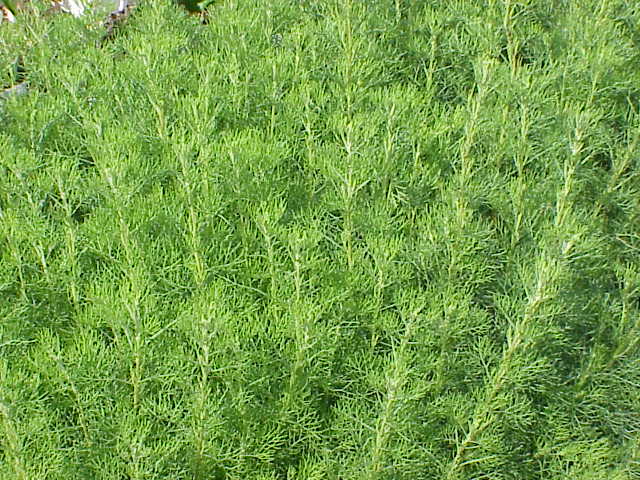- Southernwood
regnum =Plant ae
divisio = Magnoliophyta
classis =Magnoliopsida
ordo =Asterales
familia =Asteraceae
genus = Artemisia
species = "A. abrotanum"
binomial = "Artemisia abrotanum"
binomial_authority = L.Southernwood ("Artemisia abrotanum") is a
flowering plant . Found inEurope , the genus "Artemisia" was named for the GoddessArtemis . Southernwood is known by many other names including Old Man, Boy's Love, Oldman Wormwood, Lover's Plant, Appleringie, Garderobe, Our Lord's Wood, Maid's Ruin, Garden Sagebrush, European Sage, Lad's Love, Southern Wormwood, and Lemon Plant.The plant is a member of the
genus "Artemisia", along with mugwort andWormwood (an ingredient in the popular and infamous liquorabsinthe , once widely banned, but available again in Europe and as of mid-2007 in the United States as well). Southernwood has a strongcamphor -like odour and was historically used as an air freshener orstrewing herb .It forms a small bushy
shrub , which is widely cultivated by gardeners. The grey-green leaves are small, narrow and feathery. The small flowers are yellow. It can easily be propagated by cuttings, or by division of the roots.Uses
Medicinal
Southernwood encourages
menstruation (Culpeper 1653), isantiseptic and killsintestinal worms . It was used to treatliver ,spleen andstomach problems. It is seldom used medicinally today, except inGermany , wherepoultice s are placed on wounds, splinters and skin conditions and it is employed occasionally to treatfrostbite . Its constituents have been shown to stimulate thegallbladder andbile , which improves digestion and liver functions. The leaves are mixed with other herbs in aromatic baths and is said to counter sleepiness. An infusion of the leaves is said to work as a natural insect repellent when applied to the skin or if used as a hair rinse is said to combat dandruff.Historical
The Romans believed it protected men from
impotence . It is also said that young men in areas likeSpain andItaly rubbed fresh southernwood leaves (which werelemon -scented) on their faces to promote the growth of a beard.In rural areas, where southernwood was known as Lad's Love and Maid's Ruin, the herb acquired a reputation for increasing young men's virility. It was popularly employed in
love potion s and adolescent boys rubbed an ointment on their cheeks to speed up the growth of facial hair. It is associated with sexual appeal and has been used by males to increase their virility. Southernwood was put under mattresses inAncient Greece andAncient Rome to rouse lust in their occupants. Its common nickname, Lad's Love, refers to the habit of including a spray of the plant in country bouquets presented by lovers to their lasses in order to seduce them. It was used in medieval times.Other
A yellow dye can be extracted from the branches of the plant, for use with
wool . Its dried leaves are used to keepmoth s away from wardrobes. Burned as an incense, southernwood guards against trouble of all kinds, and the smoke drives awaysnake s (Culpeper 1653). The volatile oil in the leaves is responsible for the strong, sharp, scent which repels moths and other insects. It was customary to lay sprays of the herb amongst clothes, or hang them in closets, and this is the origin of southernwood's French name, garderobe ("clothes-preserver"). Judges carried posies of southernwood andrue to protect themselves from prisoner's contagious diseases, and some church-goers relied on the herb's sharp scent to keep them awake during long sermons.The pungent, scented leaves and flowers are used in herbal teas. Young shoots were used to flavor pastries and puddings. In Italy, it is used as a culinary herb.
ources
*Nicholas Culpeper, "The English Physician, or Herball", 1653, Bloomsbury Edition: 1985, Bloomsbury Books: London
External links
* [http://www.uni-graz.at/~katzer/engl/Arte_abr.html Southernwood Spice Page]
* [http://davesgarden.com/pf/go/1139/ Detailed information and pictures from PlantFiles]
Wikimedia Foundation. 2010.

